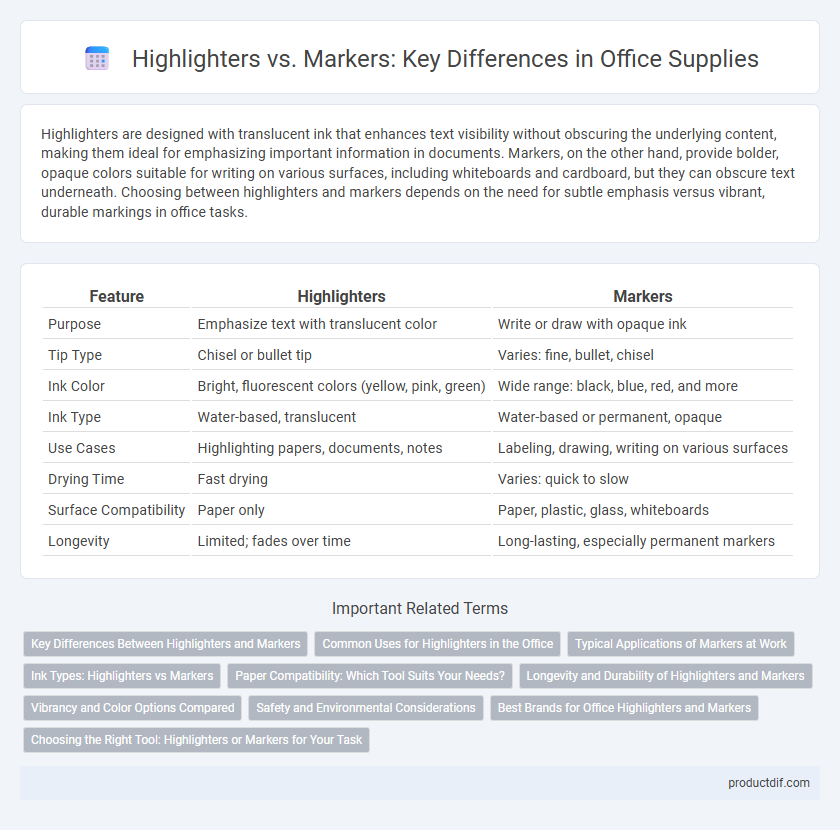Highlighters are designed with translucent ink that enhances text visibility without obscuring the underlying content, making them ideal for emphasizing important information in documents. Markers, on the other hand, provide bolder, opaque colors suitable for writing on various surfaces, including whiteboards and cardboard, but they can obscure text underneath. Choosing between highlighters and markers depends on the need for subtle emphasis versus vibrant, durable markings in office tasks.
Table of Comparison
| Feature | Highlighters | Markers |
|---|---|---|
| Purpose | Emphasize text with translucent color | Write or draw with opaque ink |
| Tip Type | Chisel or bullet tip | Varies: fine, bullet, chisel |
| Ink Color | Bright, fluorescent colors (yellow, pink, green) | Wide range: black, blue, red, and more |
| Ink Type | Water-based, translucent | Water-based or permanent, opaque |
| Use Cases | Highlighting papers, documents, notes | Labeling, drawing, writing on various surfaces |
| Drying Time | Fast drying | Varies: quick to slow |
| Surface Compatibility | Paper only | Paper, plastic, glass, whiteboards |
| Longevity | Limited; fades over time | Long-lasting, especially permanent markers |
Key Differences Between Highlighters and Markers
Highlighters feature translucent ink designed to emphasize text without obscuring underlying content, making them ideal for note-taking and studying. Markers use opaque, saturated ink suited for bold, vibrant applications on various surfaces such as paper, cardboard, and whiteboards. The tip of highlighters is typically chisel-shaped for broad strokes, while markers come in diverse tip styles, including fine, bullet, and brush, to accommodate different creative needs.
Common Uses for Highlighters in the Office
Highlighters are essential in the office for emphasizing important text in documents, reports, and presentations, making key information easily identifiable at a glance. They are commonly used for color-coding notes, organizing tasks, and prioritizing deadlines to enhance productivity and workflow. Unlike markers, highlighters feature translucent ink designed to stand out without obscuring the underlying text, ensuring clarity during review and collaboration.
Typical Applications of Markers at Work
Markers are essential for creating bold, vibrant visuals on whiteboards, flip charts, and posters during presentations and brainstorming sessions. They provide permanent or semi-permanent ink for labeling files, boxes, and office equipment, enhancing organization and identification. Their versatility extends to marking on various surfaces such as plastic, metal, and glass, making them indispensable tools in office environments.
Ink Types: Highlighters vs Markers
Highlighters use fluorescent, water-based ink designed to emphasize text without obscuring it, ensuring clarity and readability on paper. Markers typically contain pigment or dye-based ink, available in permanent, water-resistant, or washable formulas, offering bold, opaque coverage suited for various surfaces. The ink type in highlighters promotes quick drying and minimal bleeding, while markers provide diverse pigmentation for strong color intensity and durability.
Paper Compatibility: Which Tool Suits Your Needs?
Highlighters are designed specifically for use on standard office paper, providing translucent color that enhances text without obscuring it, making them ideal for note-taking and document review. Markers, on the other hand, vary widely in ink type and tip size, often producing opaque and bold lines suited for non-porous surfaces like whiteboards or glossy paper but may bleed through typical office paper. Selecting between highlighters and markers depends on your paper type and the level of visibility or permanence required for your markings.
Longevity and Durability of Highlighters and Markers
Highlighters typically offer longer-lasting ink designed for frequent use on paper without smudging or fading, maintaining vibrant visibility over time. Markers often feature more durable tips constructed from synthetic fibers, allowing them to withstand heavy pressure and rough surfaces, but their ink may dry out faster if not capped properly. Choosing between highlighters and markers depends on the required longevity of ink visibility versus the physical durability of the writing tool.
Vibrancy and Color Options Compared
Highlighters offer fluorescent, translucent colors designed to emphasize text without obscuring it, typically available in neon yellow, pink, green, orange, and blue hues. Markers provide a broader spectrum of vibrant, opaque colors suitable for bold writing and creative projects, including primary and pastel shades, metallics, and specialty inks. The choice between highlighters and markers depends on desired vibrancy and color variety, with highlighters excelling in brightness for text emphasis and markers delivering richer, more diverse color options for versatile applications.
Safety and Environmental Considerations
Highlighters generally contain non-toxic, water-based ink that evaporates quickly, making them safer for indoor use compared to markers, which often emit stronger fumes due to solvent-based inks. Environmentally, many highlighters are designed with refillable or recyclable components, reducing waste, whereas markers frequently use non-recyclable plastics and solvents harmful to air quality. Choosing products labeled as low-VOC or made with biodegradable materials can significantly lessen environmental impact and ensure safer use in office environments.
Best Brands for Office Highlighters and Markers
Stabilo, Sharpie, and Zebra are top brands known for producing high-quality office highlighters and markers that offer vibrant colors and smooth application for professional use. Office Depot and BIC also provide reliable, affordable options with a wide range of hues suitable for various highlighting and marking tasks. Choosing products from these trusted brands ensures durability, quick-drying ink, and excellent ink retention, essential for efficient office productivity.
Choosing the Right Tool: Highlighters or Markers for Your Task
Highlighters are ideal for emphasizing text with translucent, bright colors that do not obscure the original content, making them perfect for studying or reviewing documents. Markers provide bold, opaque lines suited for labeling, creating signs, or artistic projects where strong visibility and durability matter. Selecting between highlighters and markers depends on whether the task requires subtle emphasis or vibrant, lasting marks on various surfaces.
Highlighters vs Markers Infographic

 productdif.com
productdif.com